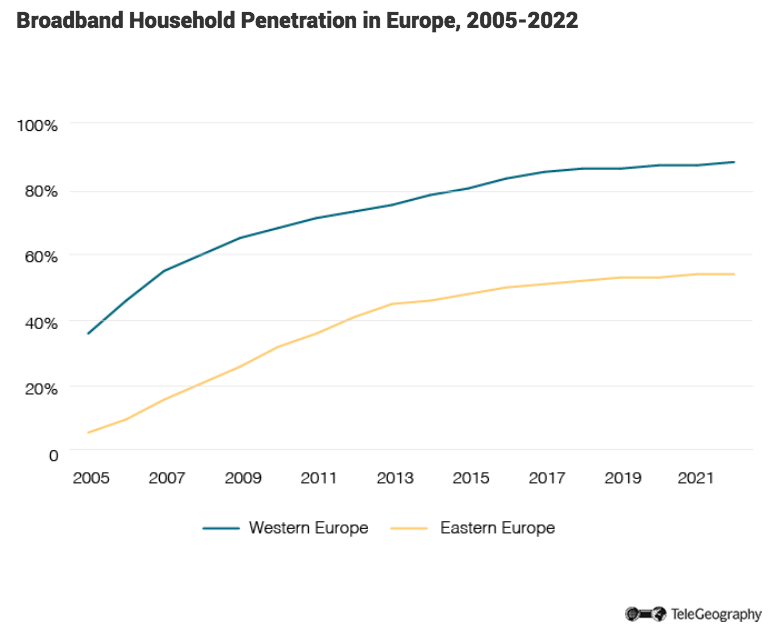The market for fixed broadband internet access in Europe has changed course.
With internet sectors in many countries approaching a saturation point, operators have moved away from expanding their physical footprints and growing their subscriber bases. They’re now concentrating more on improving the breadth and speed of their services and increasing revenue from existing customers by cross-selling other products such as pay-TV.

The quest for ever-faster broadband has also had an impact on the technological make-up of the sector, leading telcos away from traditional copper phone lines and basic cable TV systems to more advanced fiber-based equipment.
Incumbent operators that previously controlled the majority of fixed infrastructure are now finding themselves up against newer players who are pushing to deploy their own high-speed infrastructure, while market liberalization efforts by regulators and bodies like the European Union (EU) have played their part in allowing new entrants to make an impact.
Slowing Growth
The effects of market saturation can be seen in the annual subscriber growth rate across Western and Eastern Europe, falling from 37 percent in 2006 to just 4 percent in 2016. Forecasts suggest that regional growth will drop to around 1 percent by 2019 and remain at that level over the following three years.
Broadband Subscribers in Europe, 2005-2022 (millions)
| Western Europe | Eastern Europe | Europe Total | CAGR | |
| 2005 | 58 | 6 | 64 | |
| 2006 | 76 | 12 | 88 | 37% |
| 2007 | 92 | 19 | 112 | 27% |
| 2008 | 103 | 26 | 129 | 16% |
| 2009 | 113 | 33 | 145 | 12% |
| 2010 | 119 | 40 | 159 | 10% |
| 2011 | 125 | 46 | 171 | 7% |
| 2012 | 129 | 52 | 181 | 6% |
| 2013 | 134 | 57 | 192 | 6% |
| 2014 | 140 | 59 | 199 | 4% |
| 2015 | 145 | 63 | 208 | 5% |
| 2016 | 151 | 65 | 216 | 4% |
| 2017 | 155 | 67 | 222 | 3% |
| 2018 | 158 | 68 | 226 | 2% |
| 2019 | 160 | 69 | 229 | 1% |
| 2020 | 161 | 70 | 231 | 1% |
| 2021 | 162 | 70 | 232 | 1% |
| 2022 | 164 | 70 | 234 | 1% |
There were around 216 million fixed line internet customers in Europe by the end of 2016, according to TeleGeography’s GlobalComms Database, up from 208 million a year before and below 200 million at end-2014. Preliminary figures suggest that the subscriber total rose to approximately 222 million by the end of 2017 and will hit 234 million by 2022.
DSL on the Wane
In terms of technology split, DSL (including fiber-to-the-curb/VDSL) accounted for around 53 percent of all lines at the end of September 2017, down from 56 percent 12 months prior, followed by fiber-based services with 24 percent, up from 20 percent at end-September 2016. The remainder is made up of cable broadband lines (21 percent), fixed-wireless access (1 percent), and other technologies such as satellite (1 percent).
European Broadband Subscriptions by Technology, Sep 2017
| DSL | 116,553,748 | 52.8% |
| Cable | 45,702,115 | 20.7% |
| Fiber | 52,496,296 | 23.8% |
| Fixed-wireless | 3,349,974 | 1.5% |
| Other | 2,721,195 | 1.2% |
| Total | 220,823,328 |
EU Targets
The EU is looking for member states to have full population coverage of 30Mbps services by 2020, with half of all premises to have access to connections offering speeds of 100Mbps or higher.
Markets such as Belgium, the Netherlands, Germany, and the U.K.—still looking to meet the EU goals despite the Brexit vote—with widespread cable broadband networks are well on the way to achieving the first of these targets.
Meanwhile, countries including Portugal and Latvia are well positioned to hit the second figure thanks to major deployments of fiber-to-the-premises (FTTP) equipment (also known as fiber-to-the-home, FTTH). Scandinavian markets like Sweden and Finland are also well-served with FTTP networks, with a number of 1Gbps retail services already on offer.
Lack of FTTP
While the U.K. and Germany score highly in terms of broadband coverage, they may still struggle to reach the 50 percent figure for 100Mbps access by 2020 due to the relative lack of FTTP networks; less than 10 percent of homes in these two countries had access to 100Mbps services at the end of 2016 according to EU figures, with cable broadband networks accounting for the bulk of these.
In the U.K., Openreach, the network unit of former monopoly operator BT, has so far relied on a combination of fiber-to-the-cabinet and VDSL technologies which provides slower connection speeds than those offered by pure fiber. It does say, however, that it is aiming to reach 10 million premises with G.fast equipment–offering peak download speeds of up to 300Mbps–by 2020, with a further 2 million to be connected via FTTP by the same date. The firm says that “under the right conditions,” it could speed up its FTTP deployment to pass 10 million premises by 2020.
Italy Catching Up
Meanwhile, in countries such as Italy that lack a nationwide cable broadband infrastructure, efforts have been made to ramp up fiber deployments to hit EU targets. Italy previously had one of the lowest penetration rates among all EU members, but the picture is changing.
State-backed utility company Enel has set up a new unit dubbed Open Fiber, which has begun rolling out FTTP networks in major urban areas with plans to cover 80 percent of homes in over 200 cities. Rather than provide consumer services itself, Open Fiber acts as a wholesale operator, reselling access to third-party ISPs such as Vodafone Italy and Wind Tre.
The Italian government has also awarded Open Fiber a series of public-private contracts under which the firm will receive subsidies to deploy broadband networks in unserved and underserved rural areas that would normally be seen as uneconomical for a commercial rollout.
So, while subscriber growth may have slowed considerably, it can be seen that Europe is still home to some incredibly dynamic fixed broadband markets. All the latest developments can be followed in TeleGeography’s GlobalComms Database, and the free daily newsletter CommsUpdate.
Pete Bell
Pete Bell is a Senior Analyst for TeleGeography’s GlobalComms Database and also contributes to the daily CommsUpdate newsletter. He has a particular interest in wireless broadband and was responsible for TeleGeography’s 4G Research Service until it was integrated into GlobalComms.

